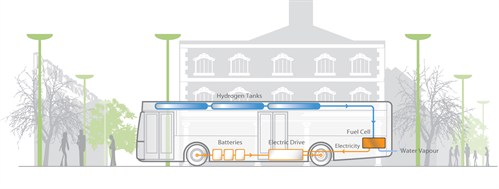Applications
Transport
Fuel cells for the transport industry can be defined as any units that provide propulsive power to a vehicle, directly or indirectly (i.e. as range extenders).

- Forklift trucks and other goods handling vehicles such as airport baggage trucks etc
- Two- and three-wheeler vehicles such as scooters
- Light duty vehicles (LDVs), such as cars and vans
- Buses and trucks
- Trains and trams
- Ferries and smaller boats
- Manned light aircraft
- Unmanned aerial vehicles (UAVs) and unmanned undersea vehicles (UUVs), for example, for reconnaissance
Fuel cell LDVs have so far seen limited use but this is set to change as most major automakers have targeted 2015 for initial commercial sales of their fuel cell vehicles. Initial locations for this rollout will most likely concentrate around clusters of early hydrogen refuelling infrastructure in Japan, Germany and the USA, and will then spread outwards from these centres as the market is established.
The fuel cell bus sector is showing year-on-year growth, with more prototypes being unveiled. Successful deployments have taken place in Europe, Japan, Canada and the USA but the high capital cost is still a barrier to widespread adoption. However, it is hoped that soon after 2014 fuel cell bus prices will be comparable to diesel-hybrid bus prices.
‘Niche’ transport consists of a number of sub-applications with differing levels of commercial success to date. Materials handling vehicles account for over 90% of niche transport shipments, with PEMFC technology dominating. This market has seen much success in the USA so far. Unmanned aerial vehicles (UAVs), e-bikes and trains amongst others are still under development with limited deployments to date.
Source: Fuel Cell Today (www.fuelcelltoday.com)









